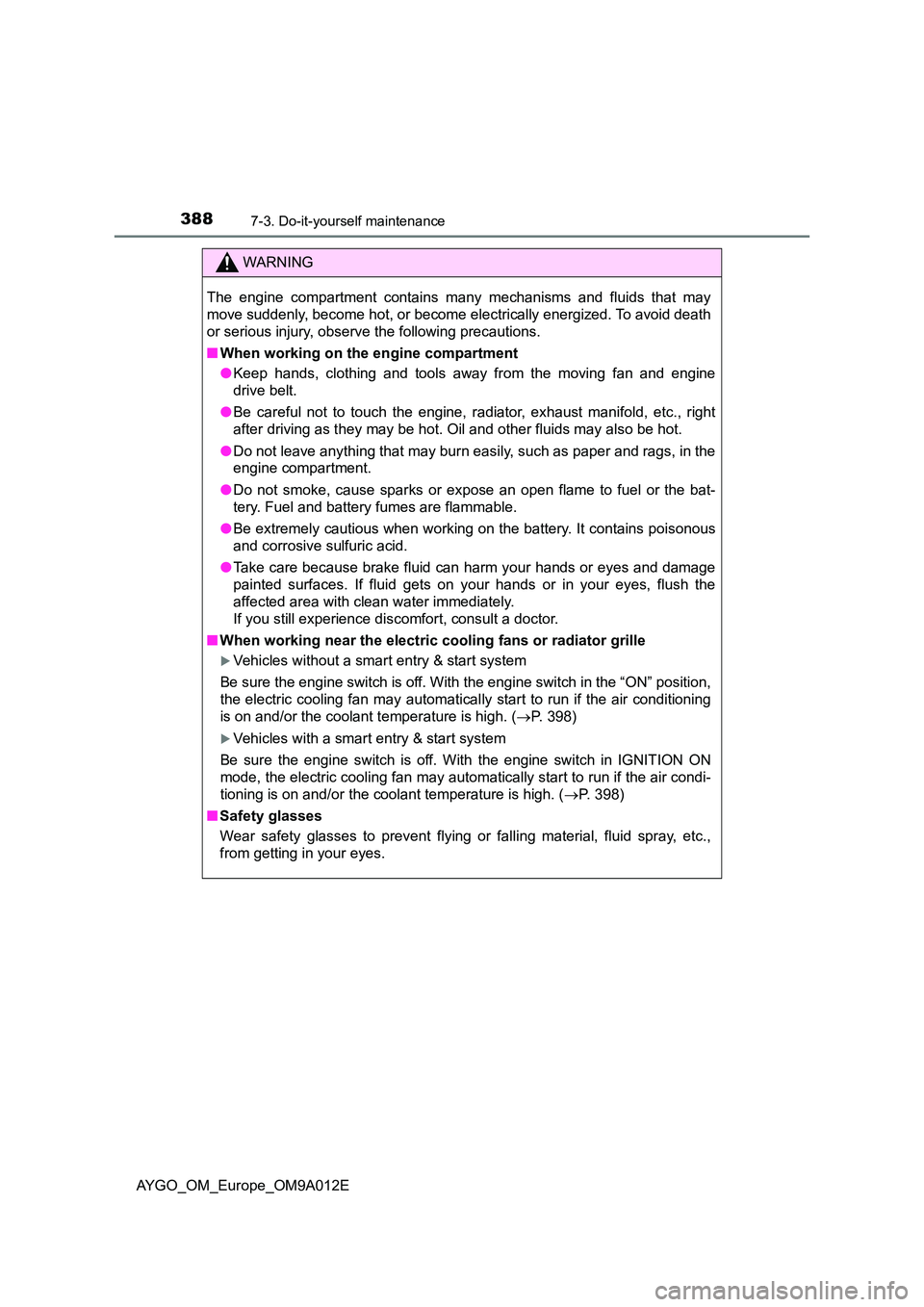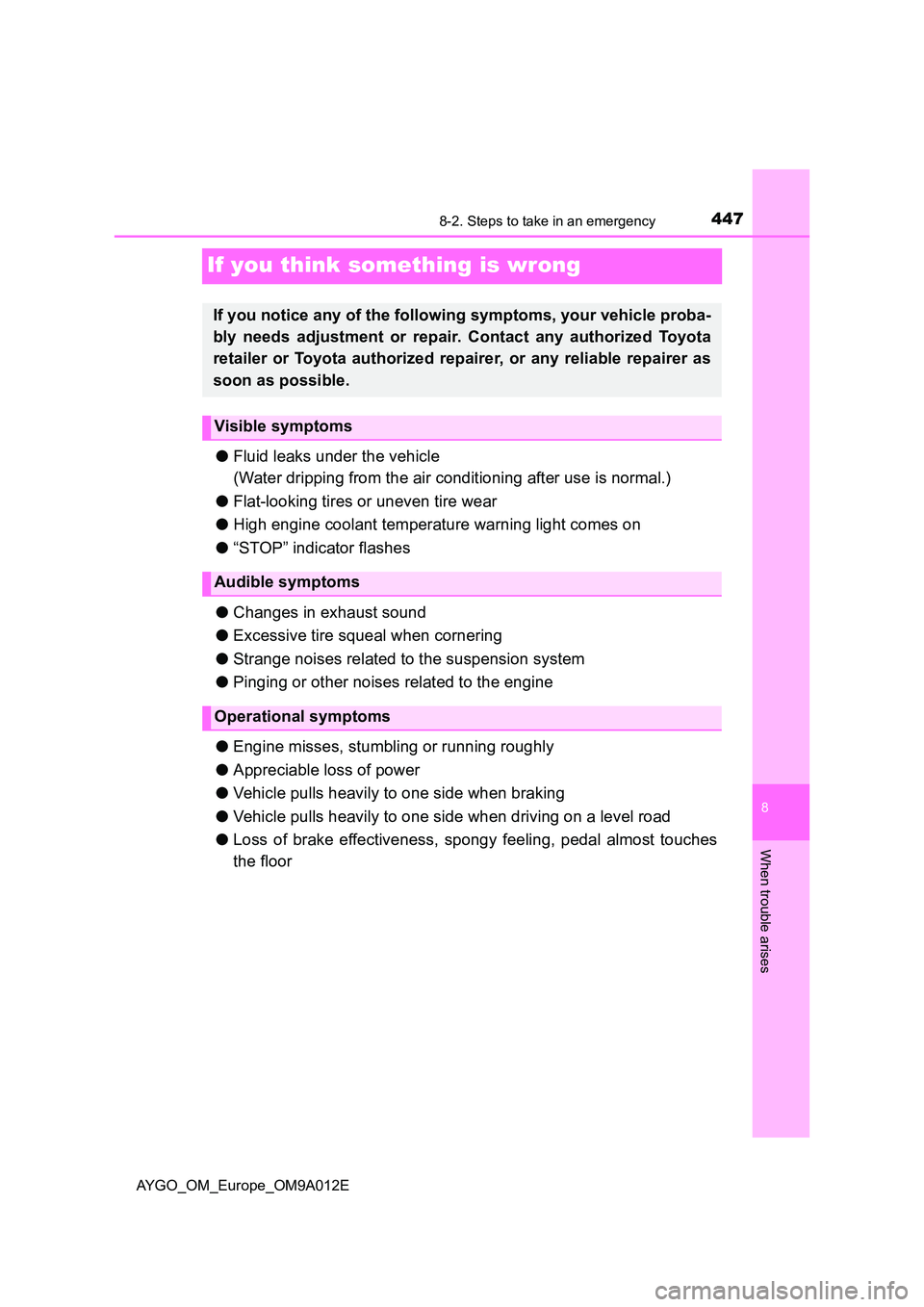2021 TOYOTA AYGO coolant temperature
[x] Cancel search: coolant temperaturePage 101 of 546

992. Instrument cluster
2
Instrument cluster
AYGO_OM_Europe_OM9A012E
Warning lights inform the driver of malfunctions in the indicated vehi-
cle’s systems.
Warning lights
*1Brake system warning
light ( P. 449)
*1Electric power steering
system warning light
( P. 451)
*1
Charging system
warning light ( P. 449)
*1, 2, 4
PCS warning light
( P. 452)
*1
Low engine oil pressure
warning light ( P. 449)
*2, 3
(Yellow)
Speed limiter indicator
( P. 452)
*1High engine coolant
temperature warning
light ( P. 450)
*1, 2, 4
Stop & Start cancel
indicator ( P. 452)
*1“STOP” warning light
( P. 450)
*1
Slip indicator light
( P. 453)
*1, 2Multi-mode manual
transmission
warning light ( P. 450)
*2
(Yellow)
LDA indicator (P. 453)
*1, 2, 4
Heat clutch warning light
( P. 450)
*2, 7
(Yellow)
Lane marker indicators
( P. 453)
*1
Malfunction indicator
lamp ( P. 451)
*2, 5
(Yellow)
Smart entry & start
system indicator light
( P. 453, 457)
*1SRS warning light
( P. 451)
Open door warning light
( P. 453)
*1
ABS warning light
( P. 451)
Driver’s and front pas-
senger’s seat belt
reminder light ( P. 453)
Page 104 of 546

1022. Instrument cluster
AYGO_OM_Europe_OM9A012E
WARNING
■If a safety system warning light does not come on
Should a safety system light such as the ABS and SRS warning light not
come on when you start the engine, this could mean that these systems are
not available to help protect you in an accident, which could result in death
or serious injury. Have the vehicle inspected by any authorized Toyota
retailer or Toyota authorized repairer, or any reliable repairer immediately if
this occurs.
NOTICE
■ To prevent damage to the engine and its components
The engine may be overheating if the high engine coolant temperature
warning light flashes or turns on. In this case, immediately stop the vehicle
in a safe place, and check the engine after it has cooled completely.
( P. 5 0 4 )
Page 276 of 546

2744-6. Using the driving support systems
AYGO_OM_Europe_OM9A012E
■Operating conditions
●The Stop & Start system is operational when all of the following conditions
are met:
• The engine is adequately warmed up.
• The battery is sufficiently charged.
• The driver’s door is closed.
• The hood is closed.
• The driver’s seat belt is fastened.
• The clutch pedal is not being depressed.
• The shift lever is in N.
●In the following circumstances the engine may not be stopped by the Stop &
Start system. This is not a malfunction of the Stop & Start system.
• The engine coolant temperature is extremely high or low.
• The outside temperature is extremely low.
• The air conditioning system is being used when the vehicle interior tem-
perature is extremely high such as after the vehicle was parked under the
hot sun.
• The air conditioning system is being used when the outside temperature
is high or low.
• Vehicles with an automatic air conditioning system only: The windshield
defogger is being used.
• The battery is not sufficiently charged, or is undergoing a periodic
recharge.
• Due to traffic or other circumstances the vehicle is stopped repeatedly,
resulting in the amount of time the engine is stopped by the Stop & Start
system to become excessively high.
• The brake booster vacuum is low.
• A large amount of electricity is being used.
• At high altitude.
When the above conditions improve, the Stop & Start system will stop and
restart the engine from the next time the vehicle is stopped.
Page 277 of 546

2754-6. Using the driving support systems
4
Driving
AYGO_OM_Europe_OM9A012E●In the following situations, the engine may start even without the clutch
pedal being depressed.
• The brake pedal is pumped or strongly depressed.
• The air conditioning system is being used or turned on.
• Vehicles with an automatic air conditioning system only: The windshield
defogger is turned on.
• The battery is not sufficiently charged.
• The vehicle starts to roll on an incline.
• A large amount of electricity is being used.
• The driver’s door is opened.
• The driver’s seat belt is unfastened.
●In the following situations, it may take longer than normal for the Stop & Start
system to activate.
• The battery is discharged.
• After the battery terminals have been disconnected and reconnected
after a battery replacement, etc.
• The engine coolant temperature is low.
■Automatic reactivation of the Stop & Start system
Vehicles without a smart entry & start system: Even if the Stop & Start system
is disabled by the Stop & Start cancel switch, it will be automatically re-
enabled once the engine switch is turned to the “LOCK” position then to the
“START” position.
Vehicles with a smart entry & start system: Even if the Stop & Start system is
disabled by the Stop & Start cancel switch, it will be automatically re-enabled
once the engine switch is turned off then the engine is started.
Page 388 of 546

3867-2. Maintenance
AYGO_OM_Europe_OM9A012E
■ Does your vehicle need repairs?
Be on the alert for changes in performance and sounds, and visual tip-offs
that indicate service is needed. Some important clues are:
● Engine misses, stumbling or pinging
● Appreciable loss of power
● Strange engine noises
● A fluid leak under the vehicle (However, water dripping from the air condi-
tioning system after use is normal.)
● Change in exhaust sound (This may indicate a dangerous carbon monoxide
leak. Drive with the windows open and have the exhaust system checked
immediately.)
● Flat-looking tires, excessive tire squeal when cornering, uneven tire wear
● Vehicle pulls to one side when driven straight on a level road
● Strange noises related to suspension movement
● Loss of brake effectiveness, spongy feeling brake pedal or clutch pedal,
pedal almost touches the floor, vehicle pulls to one side when braking
● Engine coolant temperature continually higher than normal
If you notice any of these clues, take your vehicle to any authorized Toyota
retailer or Toyota authorized repairer, or any reliable repairer as soon as pos-
sible. Your vehicle may need adjustment or repair.
WARNING
■ If your vehicle is not properly maintained
Improper maintenance could result in serious damage to the vehicle and
possible death or serious injury.
■ Handling of the battery
Battery posts, terminals and related accessories contain lead and lead com-
pounds which are known to cause brain damage. Wash your hands after
handling. ( P. 399)
Page 390 of 546

3887-3. Do-it-yourself maintenance
AYGO_OM_Europe_OM9A012E
WARNING
The engine compartment contains many mechanisms and fluids that may
move suddenly, become hot, or become el ectrically energized. To avoid death
or serious injury, observe the following precautions.
■ When working on the engine compartment
● Keep hands, clothing and tools away from the moving fan and engine
drive belt.
● Be careful not to touch the engine, radiator, exhaust manifold, etc., right
after driving as they may be hot. Oil and other fluids may also be hot.
● Do not leave anything that may burn easily, such as paper and rags, in the
engine compartment.
● Do not smoke, cause sparks or expose an open flame to fuel or the bat-
tery. Fuel and battery fumes are flammable.
● Be extremely cautious when working on the battery. It contains poisonous
and corrosive sulfuric acid.
● Take care because brake fluid can harm your hands or eyes and damage
painted surfaces. If fluid gets on your hands or in your eyes, flush the
affected area with clean water immediately.
If you still experience discomfort, consult a doctor.
■ When working near the electric cooling fans or radiator grille
Vehicles without a smart entry & start system
Be sure the engine switch is off. With the engine switch in the “ON” position,
the electric cooling fan may automatical ly start to run if the air conditioning
is on and/or the coolant temperature is high. ( P. 398)
Vehicles with a smart entry & start system
Be sure the engine switch is off. With the engine switch in IGNITION ON
mode, the electric cooling fan may automatically start to run if the air condi-
tioning is on and/or the coolant temperature is high. ( P. 398)
■ Safety glasses
Wear safety glasses to prevent flying or falling material, fluid spray, etc.,
from getting in your eyes.
Page 399 of 546

3977-3. Do-it-yourself maintenance
7
Maintenance and care
AYGO_OM_Europe_OM9A012E
The coolant level is satisfactory if it is between the “FULL” or “F” and
“LOW” lines on the reservoir when the engine is cold.
Ty pe A
Reservoir cap
“FULL” line
“LOW” line
If the level is on or below the
“LOW” line, add coolant up to the
“FULL” line.
Ty pe B
Reservoir cap
“F” line
“LOW” line
If the level is on or below the
“LOW” line, add coolant up to the
“F” line.
■Coolant selection
Only use “Toyota Super Long Life Coolant” or a similar high quality ethylene
glycol based non-silicate, non-amine, non-nitrite, and non-borate coolant with
long-life hybrid organic acid technology.
“Toyota Super Long Life Coolant” is a mixture of 50% coolant and 50%
deionized water. (Minimum temperature: -35C [-31F])
For more details about coolant, contact any authorized Toyota retailer or Toy-
ota authorized repairer, or any reliable repairer.
■If the coolant level drops within a short time of replenishing
Visually check the radiator, hoses, engine coolant reservoir cap, drain cock
and water pump.
If you cannot find a leak, have any authorized Toyota retailer or Toyota autho-
rized repairer, or any reliable repairer, test the cap and check for leaks in the
cooling system.
Engine coolant
1
2
3
1
2
3
Page 449 of 546

4478-2. Steps to take in an emergency
8
When trouble arises
AYGO_OM_Europe_OM9A012E
If you think something is wrong
●Fluid leaks under the vehicle
(Water dripping from the air conditioning after use is normal.)
● Flat-looking tires or uneven tire wear
● High engine coolant temperature warning light comes on
● “STOP” indicator flashes
● Changes in exhaust sound
● Excessive tire squeal when cornering
● Strange noises related to the suspension system
● Pinging or other noises related to the engine
● Engine misses, stumbling or running roughly
● Appreciable loss of power
● Vehicle pulls heavily to one side when braking
● Vehicle pulls heavily to one side when driving on a level road
● Loss of brake effectiveness, spongy feeling, pedal almost touches
the floor
If you notice any of the following symptoms, your vehicle proba-
bly needs adjustment or repair. Contact any authorized Toyota
retailer or Toyota authorized repairer, or any reliable repairer as
soon as possible.
Visible symptoms
Audible symptoms
Operational symptoms